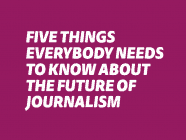A report by the Media Insight Project, an initiative of the American Press Institute and the Associated Press-NORC Center for Public Affairs Research challenges some widely held beliefs about where Americans get their news and which devices they prefer for. The Personal News Cycle study is based on a nationally representative telephone survey of 1,492 adults conducted from January 9 through February 16, 2014.
Tom Rosenstiel, executive director of the American Press Institute, spoke about the key findings. Rosentiel was also the founder and for 16 years director of the Project for Excellence in Journalism at the Pew Research Center in Washington, D.C., and co-founder and vice chair of the Committee of Concerned Journalists.
From your perspective, what is the biggest surprise in the findings?
I think it’s the idea that both our technological behavior and our news consumption is not so much driven by age and generation as people commonly think. People across generations have come to use technology to get news. On the one hand that’s not so surprising when you’re thinking about walking down the street and you see people of all ages on their cell phones. But when we think about news behavior in the abstract we still tend to think people over 60 read their news in print and people who are young get it on social media. That’s just a gross oversimplification to the point of being untrue. While younger people use social media more than old people, not even for them it’s the primary way. What’s really going on is that people of all ages are using the technology in ways that are most convenient to them. We adapt the tools to us rather than adapting to the tools.
What’s the take away for media managers?
One is that you need to be on all platforms. One good model for this might be ESPN. They are an example of a company that has really focused on their subject more than on their medium. They are sports and they are everywhere. They are web, they are mobile, they are a broadcaster, they are cable. I really don’t think we think about ESPN as a cable network any more. A second thing that the findings suggest is that as a media company you have to decide which topics or brands are essential to your existence. The topic is really driving where people go and how they get there. If you’re a local newspaper trying to be the general store that has a little of everything and not being necessarily better at anything else. You know have to have a handful of brand topics that are really your franchise. And the third thing is that you need to know your audience. The audience is determining where they want to go when and you need to understand that. Why do they come to you? What do they expect of you? And if you don’t deliver that, you will lose them because they have other alternatives. Imagine, MySpace as social network was eclipsed by Facebook, Altavista was eclipsed by Google. You can get easily eclipsed by someone developing a version of what you’re doing but only better.
Trust in news emerges as one of the main topics from the report. Do you think that this works to the advantage of legacy media?
One interesting thing is that people really do distinguish between what their news organization is and what their delivery. They know that Twitter is not a news organization or that social media is a way of discovering news. People are making those distinctions and they say that they prefer to get their news directly from the organization that is gathering the news. And for the most part those organizations tend to be legacy media. It means that if you have a history with audiences, they will be more forgiving but there’s plenty of evidence that people are adapting. They actually don’t have one news source any more. They are not just creatures of habit. They are creatures of convenience. While I think people have some patience for legacy news organizations, they are not going to use them in the same way. Those legacy news organizations need to demonstrate that they are really making use of the technology to become convenient and that they are offering real quality.
If you look five years into the future, which trends to you think will be more pronounced and which will have abated by then?
Mobile is inescapable. When the smartphone, which is really only six years old, was revolutionary and the tablet was revolutionary, you have to contemplate the possibility or even the certainty of wearable technology of people having access to the web in some form that is even more convenient today. We don’t know how that will play out but it will happen in some fashion. The other thing is that conventional advertising as we knew it, display advertising, is being displaced or evolving. We really don’t know what form that takes. We’ve never really resolved what advertising works on a computer screen. We know even less about what kind of advertising works on a smart phone. We have no inkling what commercial information will help consumers if they’re reading on glasses. What’s really been disrupted in the media model is revenue. Not demand for news but revenue, the underwriting of news. I think that the changes are moving so quickly that revenue is only going to continue to be less certain for a while.
Photo credit: Johan Larsson / Flickr CC
Tags: American Press Institute, digital news, Personal News Cycle, Pew Center, Tom Rosenstiel










































